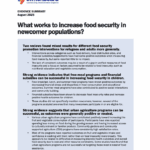Issues related to poverty and income inequality in high-income countries have led to food insecurity among some population groups, such as migrants and refugees. While there are some studies on the experience of some migrant groups (and other subpopulations), little is known about food security among Middle Eastern and African migrants and refugees. This systematic review identified the prevalence of food insecurity and its effects among Middle Eastern and North African (MENA) migrants and refugees in high-income countries. The Preferred Reporting Items for Systematic Reviews and Meta-Analyses (PRISMA) guidelines were followed in this systematic review. Four databases, namely MEDLINE (Ovid), Embase (Ovid), CINAHL (EBSCO), and PubMed were searched. Three studies met the inclusion criteria, all of which were conducted in USA: two among Sudanese migrant families, and one among Somali refugee women. The rates of reported food insecurity ranged from 40% to 71% and were significantly higher than for the general population. Food insecurity was associated with acculturation and socio-economic factors. Food insecurity adversely impacts the health of MENA migrants and refugees, creating economic implications for individuals, families, the broader community in which they now live, and for governments.
The management of volunteers – What can human resources do? A review and research agenda
There is an increasing interest from scholars and practitioners in understanding how non-profit organizations can design and implement human resources (HR) practices to enhance desirable volunteer attitudes and behaviors. This paper presents a comprehensive overview of existing studies on the relationship between HR practices and volunteering outcomes. We use the ability-motivation-opportunity model as a guiding…

